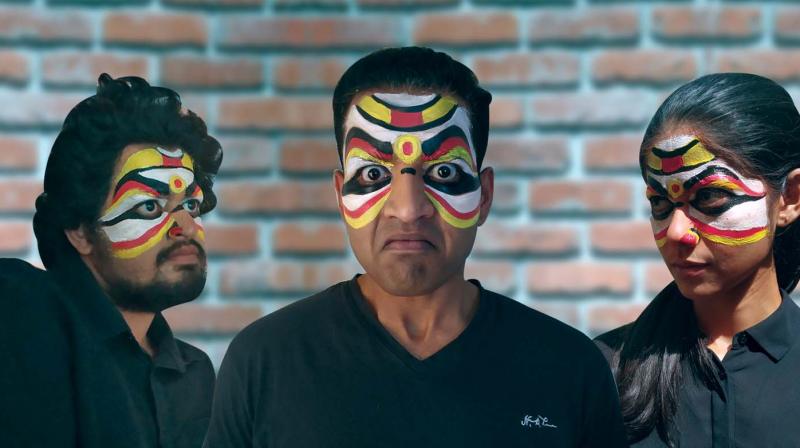When Two Worlds Meet A dash of sambar, a whiff of Tagore

Red Oleanders is one of the sixty plays that Nobel Laureate Rabindranath Tagore wrote and the last symbolic one. In the early twenties, when the poet extraordinaire was visiting Shillong, he saw a blood red flower protruding from the roadside debris of pieces of discarded iron. This imagery was symbolic enough for Tagore to write a 42-page play Red Oleanders - Rakta Karobi- which is the story of a beautiful protagonist Nandini and her fight against the oppression of humanity through greed and power.
The theme sounded relevant enough for theatre director Prithesh Bhandary to set the play in the present and stage it for the first time in the city. As he says, he too had succumbed to the writings of Tagore. “When my mentor Ranjan Ghosal of Forum Three had staged the last speech of Tagore, The Crisis of Civilisation, I had played out a small snippet. It intrigued me enough to read more of Tagore’s writings.”
Bhandary came across the play Red Oleanders and it piqued him enough to read it again and again. “At least a hundred times,” he laughed. And every time he read it, the interpretation was different but the understanding of the depth of the play deepened. The story, as Tagore himself noted, ‘is a vision that has come to me in the darkest hour of dismay’. It talks of a post-colonial society, the by-product of a materialistic system.
Simply put, it is the story of a tyrant king, the antagonist, who forces everyone in Yaksha town to dig for gold. The king is helped by his aide, the Governor, and no matter how much gold has been amassed, he is never satisfied. The digging goes on day and night by a people who don’t know how to sing, dance or have any form of merrymaking. These slaves are always trapped within a burrow, in an underground network, forced into labour by a ruler who has barricaded himself behind an iron curtain. Incidentally, for most part of Tagore’s play, the king is only a voice from behind the curtain.
When the protagonist Nandini appears in Yaksha town or the city under eclipse, she is fearless and questions everything she sees while waiting for her love Rangan, who is one of the ‘human machines’ within the network. A digger brings her the red oleander flowers which she strings into a small wreath to crown her lover. The end is tragic for Ranjan and Nandini but the people of Yaksha town emerge out of the underground with hope for a new life.
Tagore delved into several symbolisms. The people of the town are likened to Yakshas, the workers of Lord Kuber, the God of wealth. The king represents an evil regime and his aide, the governor is shown to symbolise the silent tyrant signifying that a few people in a suppressive government can control the entire country. The protagonists and their idealisms are the misfits.
Tagore shows us two worlds. One which he disapproves of, for its pursuit of material wealth, over organisation, tyranny, commercialism and all the subsequent consequences and the one he admires, which has freedom, beauty, affection, sympathy, generosity and more.
Bhandary chooses to internalise the two worlds. “There is good and bad in each one of us”, and it is this battle he chooses to show. To make the play fit into a 90-minute module, the script was reduced to thirty pages and rewritten in simple English rather than the complex English of Tagore’s. He digressed from the play by allowing some creative liberties. First, he decided to make the setting of this ‘one act’ play neutral.
“The time period and the city is ambiguous and the costumes are confusing.” For instance, some of the characters wear the highly colourful Yakshagana costumes. “I partnered with Yaksha Degula School and had Yakshagana students perform some bits,” he said.
The king, played by first-timer actor Sudhir Ghose, was elected to wear the Yakshagana costume, make-up and perform the dance in order to symbolise the ‘over-the-top’ character. Ghose is a “diehard non-dancer” and was understandably traumatised by the requirement but he persevered. “My mentor had said if you are a director, make an actor of a non-actor,” Bhandary noted, “My actors now look and sound professional.” He has incorporated a Bengali song as well. It is like serving “rosogolla and sambar”.
While the director is looking forward to the audience’s reaction and plans to take the play to Mangaluru, Puducherry and Mumbai - Bhandary is hoping to stage it at the famous Prithvi Theatre - finding red oleander flowers was a different league. “Did you know these flowers are poisonous?” he asked. “They are very hard to find, especially here.” He had to make do with plastic faux flowers handcrafted by his artist sister. A case of ‘what you think you see isn’t exactly what it is, a symbolism, that Tagore would have approved of.

